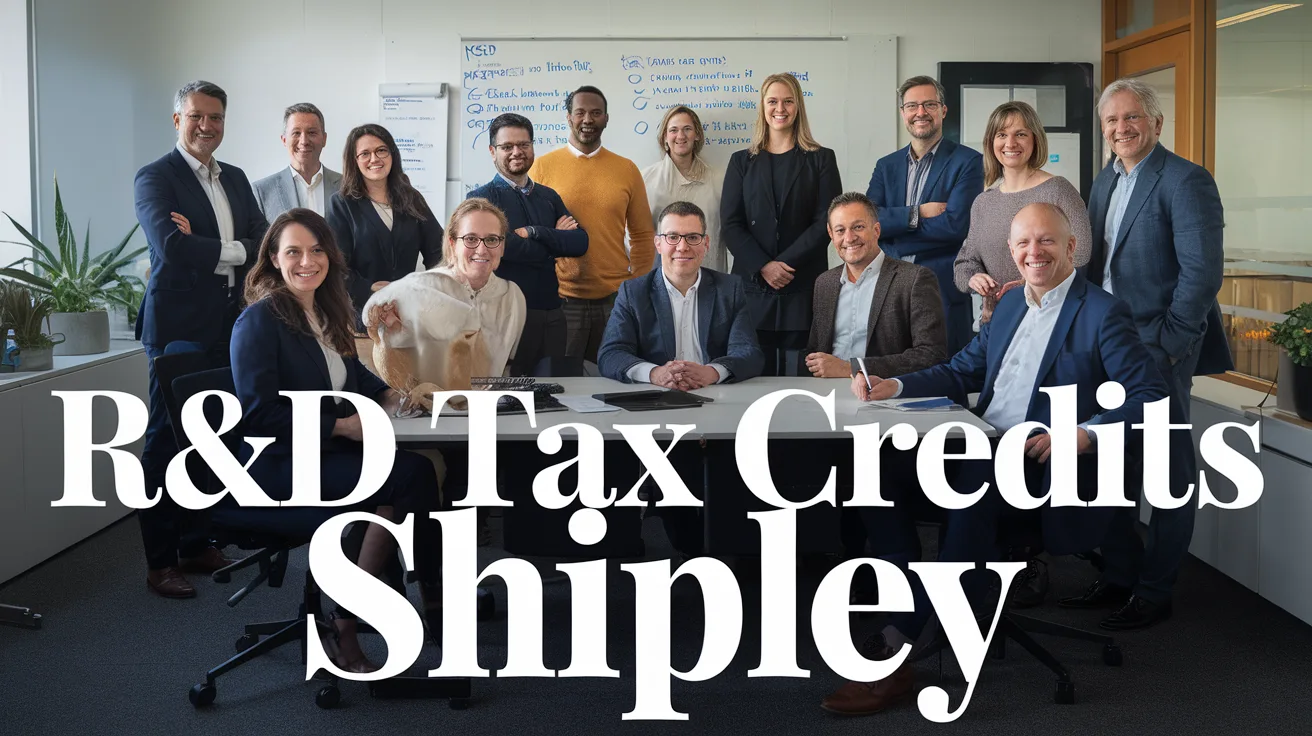R&D Tax Credits Shipley West Yorkshire
R&D Tax Credits in Shipley West Yorkshire offer substantial financial relief for businesses engaged in research and development activities. These incentives are designed to support innovation, reduce tax liabilities, and even generate cash refunds for your company.
To qualify, your business must be involved in innovative projects that resolve scientific or technological uncertainties. This includes activities aimed at achieving advances in science or technology, ensuring your team has the technical competence to carry out the R&D work.
By leveraging the expertise of R&D Tax Credit Specialists, you can maximise the benefits of these tax credits. They ensure your claim is accurate, complete, and compliant with HMRC guidelines, helping you to secure the financial support your business needs to thrive.

How Do R&D Tax Credits Benefit Shipley Businesses?
R&D tax credits significantly reduce your tax burden, boosting your company's financial health and innovation capabilities. By incentivising investment in research and development, these credits help Shipley businesses stay ahead in competitive markets.
Financial Advantages
R&D tax credits provide substantial monetary benefits, directly improving your cash flow. These credits can cover a significant portion of your R&D expenses, including staff costs, software, and materials, making it more feasible to invest in cutting-edge projects.
Competitive Edge in Innovation
Access to R&D tax credits enables you to invest more in innovation, outpacing competitors with advanced products and services. This financial support allows you to explore new technologies and methodologies, enhancing your market position and driving long-term growth.

Which Industries Commonly Claim R&D Tax Credits?
Technology Sector, manufacturing, life sciences, and others frequently claim R&D tax credits. These industries are known for their significant investment in innovation and development.
Technology Sector
The technology sector is a leading claimant of R&D tax credits. Companies in this industry often invest heavily in software development, artificial intelligence, and data analytics, making them prime candidates for these incentives.
Manufacturing
Manufacturing firms are also common claimants, particularly those involved in advanced technologies and automation. These companies often undertake extensive research to improve production processes and develop new materials.
Life Sciences
In the life sciences sector, R&D tax credits are crucial for companies working on pharmaceuticals, biotechnology, and medical devices. The high costs of clinical trials and product development make these credits especially valuable.
Others
Other industries, such as renewable energy and construction, also benefit from R&D tax credits. These sectors often engage in innovative projects that push the boundaries of technology and sustainability.

What Qualifies as R&D Under UK Tax Law?
R&D under UK tax law refers to activities that seek to achieve an advance in science or technology through the resolution of scientific or technological uncertainty. To qualify, the work must not just be routine, but must involve genuine innovation and experimentation.
Qualifying Activities
Research and Development (R&D) includes projects aimed at creating new products, processes, or services, or improving existing ones. For instance, developing new software, enhancing manufacturing processes, or creating innovative medical devices all qualify. If your project involves substantial scientific or technical challenges and is not a simple extension of existing knowledge, it likely qualifies.
Excluded Activities
Certain activities are explicitly excluded from qualifying as R&D under UK tax law. Examples include market research, management studies, and quality control. Routine data collection and analysis, as well as the creation of artistic or literary works, also do not qualify. It’s important to distinguish between activities that involve genuine innovation and those that are part of standard business operations.
When in doubt, consult with a tax advisor to ensure your activities align with the criteria set by HMRC.

How Are R&D Tax Credits Calculated?
R&D tax credits are calculated based on the eligible costs you incur during your research and development activities. These costs typically include staff salaries, materials, and certain external expenses.
SME Scheme
Under the SME Scheme, you can claim up to 130% of your eligible R&D costs. This means if you spend £100,000 on R&D, you can claim £130,000, which can significantly reduce your corporation tax liability. The SME Scheme is designed to support smaller businesses with fewer than 500 employees and a turnover or balance sheet of less than £100 million.
RDEC Scheme
For larger companies, the RDEC Scheme (Research and Development Expenditure Credit) applies, you can claim a credit of 13% of your eligible R&D costs. This credit can be offset against your corporation tax liability or, if your company is loss-making, you can receive a cash payment from HMRC. The RDEC Scheme is more complex and is intended for companies with over 500 employees or a turnover exceeding £100 million.

Recent Changes to UK R&D Tax Credits
The UK Government has introduced several updates to the R&D Tax Credits scheme, reflecting the ongoing commitment to support innovation and research in the country. These changes aim to make the scheme more accessible and beneficial for businesses.
Policy Updates
- Increased Relief for SMEs: The SME relief rate has been raised, providing more financial support for smaller companies.
- New Digital Technologies Focus: The scheme now places a stronger emphasis on digital technologies, encouraging investment in this area.
- Simplified Application Process: The application process has been streamlined to reduce the administrative burden on businesses.
These updates are designed to ensure that the scheme remains relevant and supportive of the evolving needs of businesses in the UK.
Impact on Businesses
The changes to the R&D Tax Credits scheme are expected to have a positive impact on businesses, particularly SMEs. By increasing the relief rate and simplifying the application process, more companies will be able to access the financial support they need to drive innovation and growth. This should lead to increased investment in R&D activities, fostering a more dynamic and competitive business environment in the UK.

How Can Shipley Businesses Apply for R&D Tax Credits?
Shipley businesses can apply for R&D Tax Credits by following a structured application process and providing the necessary documentation. Ensuring you have all the required details will help streamline your application.
Application Process
- Identify Eligible Activities: Determine which of your research and development activities qualify for tax credits. This includes new or improved products, processes, or services.
- Calculate Your R&D Expenditure: Track and calculate the costs associated with your eligible R&D activities. This includes staff salaries, materials, and subcontractor costs.
- Complete the HMRC Form: Fill out the R&D Tax Credit application form on the HMRC website. Ensure all fields are accurately filled to avoid delays.
- Submit Your Application: Submit the completed form online through the HMRC website. Keep copies of all documentation for your records.
Required Documentation
You will need to provide detailed documentation to support your application. This includes:
- Financial Statements: Recent financial statements that outline your R&D expenditure.
- Project Details: Descriptions of your R&D projects, including their objectives and outcomes.
- Staff Information: Details of the staff involved in R&D activities, including their roles and the time spent on these activities.
- Subcontractor Agreements: Any agreements with subcontractors who contributed to your R&D efforts.
By following these steps and providing the necessary documentation, you can successfully apply for R&D Tax Credits and benefit from potential financial support for your innovative projects.

Title: Common Pitfalls to Avoid When Claiming R&D Tax Credits
When claiming R&D tax credits, it is crucial to avoid certain mistakes that can lead to rejections or audits. Here are the key pitfalls to watch out for:
Overclaiming
Overclaiming occurs when you include ineligible costs or exaggerate the scope of your R&D activities. This can result in your claim being rejected or subject to a lengthy and costly investigation. Always ensure that the costs and activities you include in your claim are genuinely related to R&D and are supported by clear evidence.
Underclaiming
Underclaiming happens when you fail to include all eligible R&D activities and costs, resulting in a smaller credit than you are entitled to. This can happen due to a lack of awareness of what qualifies as R&D or fear of overclaiming. Review the HMRC guidelines thoroughly to ensure you are not leaving any eligible expenses out of your claim.
Documentation Errors
Documentation errors can derail your claim if you do not have the necessary evidence to support your R&D activities. This includes inaccurate records, missing invoices, or lack of detailed project descriptions. Keep meticulous records of all R&D activities, costs, and outcomes to prevent any discrepancies in your claim.

How Can Professional Advice Enhance R&D Tax Credits Claims?
Professional advice can significantly bolster your R&D tax credits claims by ensuring you maximise allowable expenditures and adhere to HMRC guidelines. By leveraging the expertise of R&D Tax Credit Specialists, you can streamline the application process and avoid common pitfalls.
Role of Tax Credit Specialists
- Identifying Eligible Projects: Specialists can help you identify which projects qualify for R&D tax credits.
- Accurate Documentation: They ensure that all necessary documentation is accurate and complete, reducing the risk of rejection.
- Navigating Complex Regulations: Specialists are well-versed in the intricate rules and regulations set by HMRC, ensuring compliance at every step.
Benefits of Expert Guidance
Expert guidance from R&D Tax Credit Specialists can save you time and minimise the stress associated with navigating the R&D tax credits process. They can also help you uncover hidden opportunities that you might not have considered on your own. This can lead to a more robust and successful claim, ultimately increasing the financial benefit for your business in West Yorkshire.
In Conclusion
R&D Tax Credits in Shipley West Yorkshire are a valuable tool for businesses looking to reduce their tax liability and invest more in innovation. By claiming these credits, you can cover a significant portion of your R&D expenses, including staff wages, software, and materials, which can greatly improve your financial health and competitive edge. If you are in the Technology Sector, manufacturing, life sciences, or other innovative industries, now is the time to explore how these credits can benefit your business. Consider working with R&D Tax Credit Specialists to ensure your claim is accurate and maximised. Don’t miss out on the opportunity to boost your company’s growth and innovation. Contact R&D Tax Credit Specialists today to get started.

